Oona
Doherty
The swaggering, graceful choreographer dances to an entirely new beat.
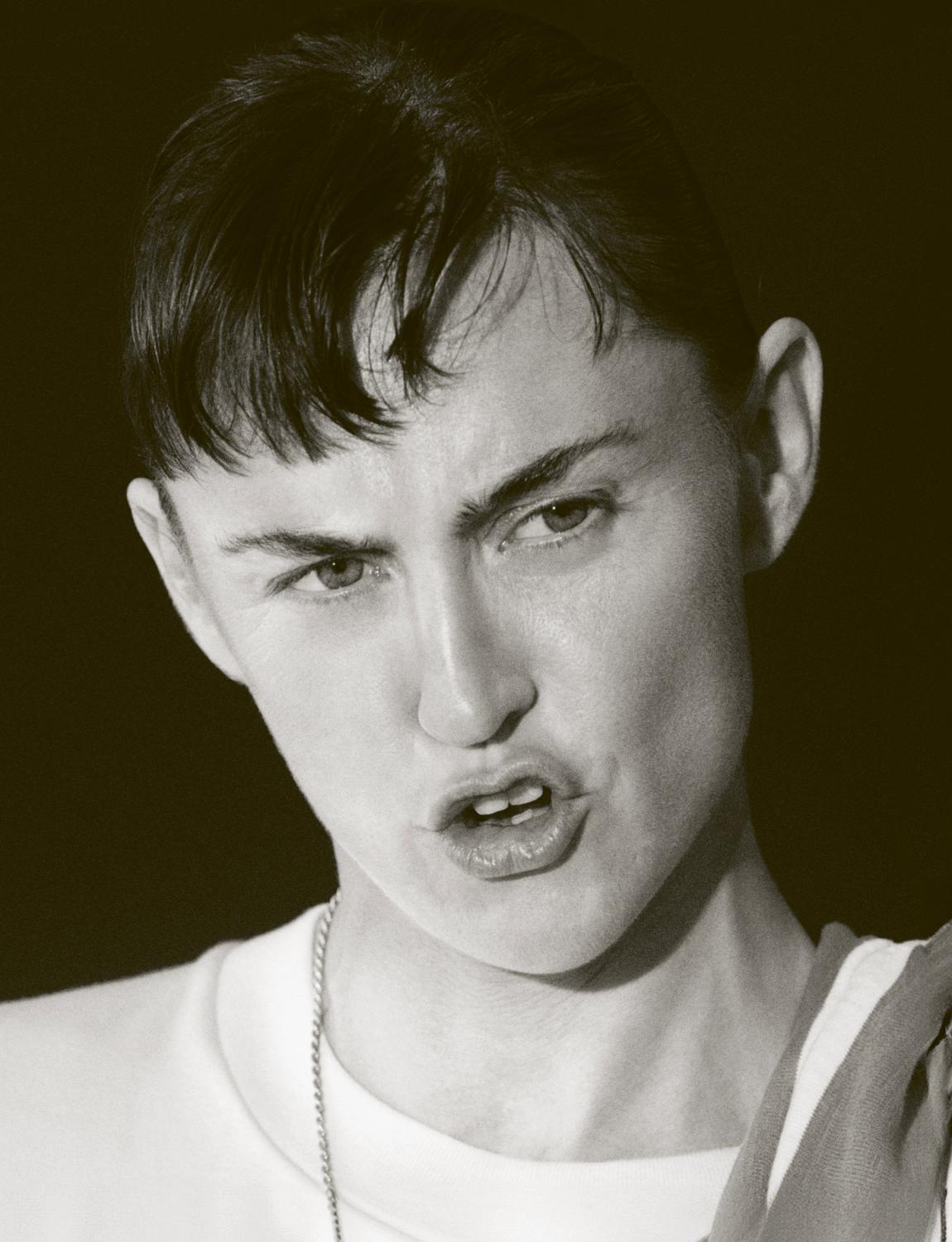
Photography by Ilya Lipkin
Styling by Eliza Conlon
Issue nº 30, Autumn and Winter 2024
Oona Doherty planned out her life choreographic aged 12, correctly predicting a career that would take her all around Europe and right to the forefront of contemporary dance. Now she’s in southernmost France with her toddler, presenting a new work inspired by the life of her great-grandfather, a butcher from Belfast.
The choreographer Oona Doherty hasn’t danced in public for years, but when she gets out of her chair to demonstrate a dander – which is what they call a laddish gait in her hometown of Belfast and of which she has become a master – it is as captivating as if she were on stage performing a solo under the spots. “Some people don’t move the pelvis when they walk,” she says, mid-prowl. “Teenage lads. What do you call them in London, road men? It’s just, like, swag, isn’t it?”
The 38-year-old is playing to an audience of one in the empty cafe of Sadler’s Wells in London on a Thursday evening, under strip lighting, to the soundtrack of the air conditioning. In two days’ time the theatre will be full, the audience there to watch her latest work, Wall, a physical expression of what it is like to be young and British today, performed by the National Youth Dance Company, of which she is this year’s guest artistic director. Against a soundscape by the Turner Prize-winning artist Mark Leckey, comprised of spoken excerpts from interviews with company members and their families and a hypnotic, building beat, the dancers start as distinct groups and gradually come together to form a sinuous wall that parts, regroups and, in one memorable sequence, falls down and gets up again and again and again. Wall ends with a glitteringly disco-tastic solo that sends the audience soaring out onto the streets. Dance Art Journal will later extol, “Doherty has captured something of the quintessential teenage experience.”
A talent for capturing experience is what has shot Oona to the forefront of contemporary dance in the past decade. Her debut choreographic work in 2016, Hope Hunt and the Ascension into Lazarus, performed at the Mac in Belfast, opened, unforgettably, with Oona as a lad bursting out of a car boot, hair slicked back, 1980s tracksuit and shoes, all wiry masculinity and attitude. Alistair Spalding, the artistic director of Sadler’s Wells, who this year appointed Oona as an associate artist, saw it at the Yard Theatre in Hackney Wick in east London in 2019. “The guy’s driving an old car and smoking cigarettes, drinking beer,” he tells me in a phone call. “It was quite real. There’s pounding music, and she gets out and starts doing a solo in the car park. Then we all go into the theatre, and you immediately saw an incredible new talent arriving.”
“If you do ballet for a while you’re good – you’re strong, you won’t get injured.”
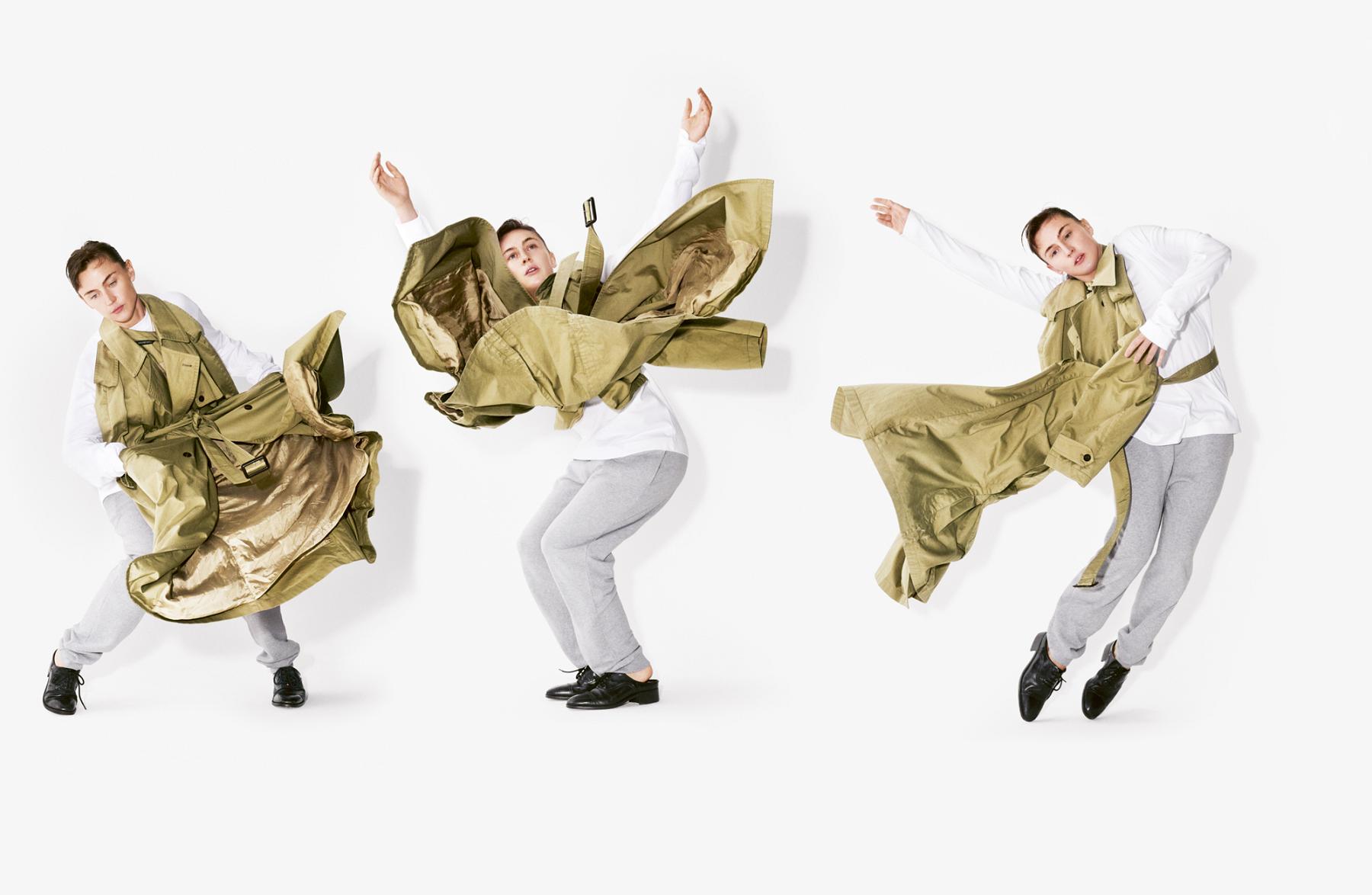
Third time’s the charm. Oona wears a beige cotton twill Suspended trench dress by BALENCIAGA around her neck. The white cotton long-sleeved T-shirt and grey cotton loop-back tracksuit bottoms are by SUNSPEL, and the black leather shoes are by TALIA BYRE.
Oona has continued to make works based on close observations of individuals and social groups, examining gender – most notably masculine stereotypes – and identity, body image and religion. “The originality of the subject matter and the precision of her dancing are qualities that she brings to everything she does,” the dance critic Sarah Crompton says by email. “She feels like the future.” Oona’s dynamic choreography, influenced by club culture, her early work with European avant-garde performers, and her own devised technique by which dancers unlearn everything their bodies have been previously disciplined to do, has brought a new audience.
“What is significant about her work is how it reaches out and speaks to many who would not normally come to the theatre,” Wayne McGregor, the esteemed choreographer, said in 2021 when he presented her with the Silver Lion at the Biennale Danza in Venice. “Her dances communicate across boundaries and demographics in arrows straight to the heart.” (Oona says she was astonished when McGregor called her to tell her about the prize. “That was mad. Because Wayne’s really famous. And he knows who you are, and he rings you and gives you an award. It was great.”)
Those who have been lucky enough to witness Oona’s and her company’s visceral dance performances might expect a more boisterous presence than the slight, friendly woman who walks into the cafe dressed in an oversized white T-shirt, cropped black trousers and thick-soled creeper shoes. Her hair is lighter than it looked in the scraped-back styles she tended to adopt when she was performing on stage. Her voice is gentle, Northern Irish wandering occasionally into Estuary English, reflecting the geographic centres of her upbringing: London until she was 10, and then Belfast. “It was like learning a different language,” she remembers of the move in 1996 to the city where her parents had grown up. “Harder for my older brother, because the English accent landed very badly in his school. At my school, the first show we did was Oliver! and I had a north London accent, so I was useful.”
Oona wasn’t in any way dance-mad before she got to Belfast. “I mean, we were dancing in the house to Michael Jackson and stuff, and I was obsessed with Grease the Musical,” she says of her life as a child in north London. “I did Irish dancing and won first place in my feis, but I wasn’t in a dance club or anything like that.” She remembers watching the BBC’s documentary series Big Cat Diary and enjoying pretending to be a lion or a cheetah, as her three-year-old daughter, Rosie, does now. It wasn’t far from what Oona’s dance teacher, Marie Mannion, asked of her students at the very first after-school dance club class that Oona attended at St Louise’s Comprehensive College in Belfast in 1997. “She put the soundtrack from Cats on and got us to improvise, crawling around the floor.”

Oona gets down in a blue denim Super Puffer jacket and blue denim Skate Super Baggy jeans, both by LEVI’S. The NIKE trainers are Oona’s own, and the rain poncho is the stylist’s.
After that Oona danced every day: ballet, contemporary and choreography, a mix she would later find out was un-usual but one which made her think like a choreographer from the start. “Marie was amazing,” she tells me. “She expected lots from all of us, so we built up hours by coming in early to school and leaving late. There’s a lot of professional choreographers that have come out of that one dance teacher.” They include Eileen McClory, a schoolmate of Oona’s who went on to win the Arts Council of Northern Ireland’s most prestigious award in 2022.
A year after joining dance club, the 12-year-old Oona had made her “plan”. “I was like, I’m gonna be a dancer that will go on tour around Europe. I want a choreographer to make a solo for me. And then I want to be a choreographer.” As vision boards go, it has been impressively accurate, but there were hiccups. Having won a place to study at the Place in London in 2003, she found she disliked the Merce Cunningham method they taught. “It’s kind of mathematical, and I couldn’t get my head round it,” she says. “Coming from being a dance geek and the teacher’s favourite, my ego couldn’t handle that. I wavered a bit and took a bit of drugs, went partying, got kicked out.” She finished a degree in contemporary dance at the University of Ulster in Derry in 2006 and did a postgraduate degree at London’s Trinity Laban, the UK’s only conservatoire of music and contemporary dance, in 2009.
After she graduated she went to the Netherlands to dance with the avant-garde performance company Trash, which had its own unique ethos. “Kind of punk, with a lot of high heels, wigs, make-up and the most violent movement you can do,” Oona says. “I loved it because it was pushing your body to the peak of athleticism. But after four years I was like, My nervous system needs a bloody break.”

Oona grew up in Belfast, Northern Ireland, from the age of 10. She wears a blue Dry-Ex polo shirt over a white HeatTech cotton long-sleeved thermal top, both by UNIQLO. The off-white cotton trousers are by MIU MIU, and the trainers are Oona’s own, as before.
Oona moved back to Belfast in 2014 and within two years had launched her choreographic career. Hope Hunt was originally meant for a male dancer; when he withdrew at the last minute, Oona ended up dancing it herself. A solo already astounding in its observation of modern masculinity, simultaneously violent and vulnerable, became utterly remarkable when performed by its female creator. “I wasn’t thinking about gender. The gig was already booked.” She shrugs. “So I had to do it. And that’s when people started talking about gender.”
In 2019 Oona further developed some of those ideas around masculinity for her first group piece, Hard to Be Soft: A Belfast Prayer, her reflection on the city for the London festival Dance Umbrella. David Jays in The Times described Oona as a “phenomenal performer who makes the air electric”, the “adrenaline-rush star” who “steals the year as a tracksuited scally.” At times she has taken umbrage at the way her work is interpreted. “The range of the choreographic intent is way richer and non-binary, more international than pretending to be a lad from Belfast,” she says. “But now I’ve had some distance I can see that the work is about masculinity and does come from a place in me. Maybe it is about my brother and my dad. My relationship with men.”
She is not yet sure if she has come to terms with other labels. “I’ve had ins and outs of being upset about people putting the words ‘working class’ on everything I’ve ever done,” she says. “Because it really does matter career-wise and for how you’re sold. Or how you allow yourself to be sold. But your class is shifting all the time, depending on where you’re sitting. Maybe here or at the Chaillot Théâtre in Paris or Pavillon Noir in Aix-en-Provence I have a loud Belfast working-class smell about me. But if I go home then I’m probably a posh bitch.”
The first work in which Oona didn’t dance was 2019’s Lady Magma, which she toured across Europe, in Paris, Geneva, Aix-en-Provence and Belfast. She was anxious about her ability as a choreographer, saying at the time, “I haven’t had a show yet that has played and done well without me being in it. Maybe I’m just really good at dancing.” She needn’t have worried – The Stage called it “fascinating and unpredictable”.
“The range of the choreographic intent is way richer and more international than pretending to be a lad from Belfast”

Double-step twice: grey wool trousers by BURBERRY and the stylist’s own blue-and-red striped T-shirt. Balck shoes by TALIA BYRE. Opposite: beige suede calfskin trousers by LOEWE are worn with the stylist’s own blue-and-white striped T-shirt. Shoes, as before.
Oona returned to dancing – ballet, specifically – the following year during lockdown in Bangor, County Down, where she practised at her old dance school, the Susan McMillan School. “I wanted my body to feel trained again,” she tells me. “And if you do ballet for a while you’re good – you’re strong, you won’t get injured.”
This return to ballet sparked 2022’s Navy Blue, in which the dancers, who start off performing ballet moves to Rachmaninov, are picked off and seemingly shot, one by one, ending up in a pool of blue liquid. The DJ and producer Jamie xx, who had seen Hope Hunt at the Yard in 2019 and asked Oona to devise something similar for the video for his 2020 track “idontknow”, provided part of the score for Navy Blue (Oona asked him to make “the sound of dread” as the dancers are shot). “I visited Oona in France, where she and the dancers were rehearsing,” he tells me by email from London. “It’s always my favourite part of working in dance; it’s so visceral and raw and helped cement the idea and tweak the music to fit perfectly.”
“Navy Blue was a work that questioned the entire purpose of making dance,” Sarah Crompton says. Oona tells me she made it after taking a hiatus from watching the news, then coming back to it and considering the world’s position. “Yeah, Navy Blue was ‘We’re fucked,’” she says, cheerily. Contemporary dance, I suggest – particularly the way Oona does it – is able to react to the world in a way that ballet perhaps can’t. She is not sure she agrees with that. “Both art forms have possibilities to do anything, if the people who hold the power in them are willing to change,” Oona says. “Who’s booking who? Paris Opera Ballet has been going for hundreds of years, and it was only recently they hired the first Black principal dancer. It’s about who’s allowed to do ballet – the institutions, the accessibility, and the people in positions for 20 to 30 years. There’s nothing wrong with the form. It’s the gatekeepers.” Though, she adds, “I don’t think I’d ever want to be in a ballet show.”
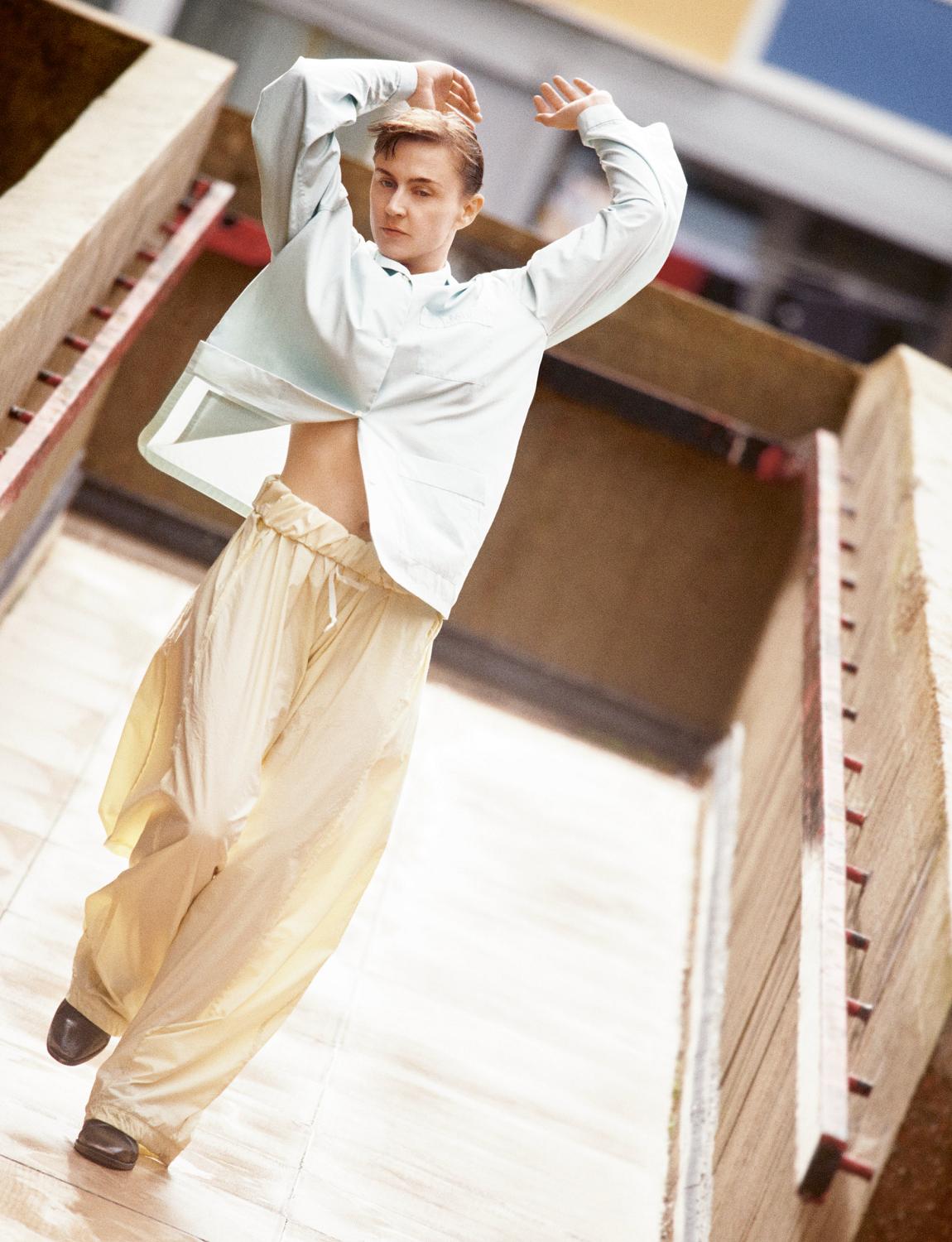
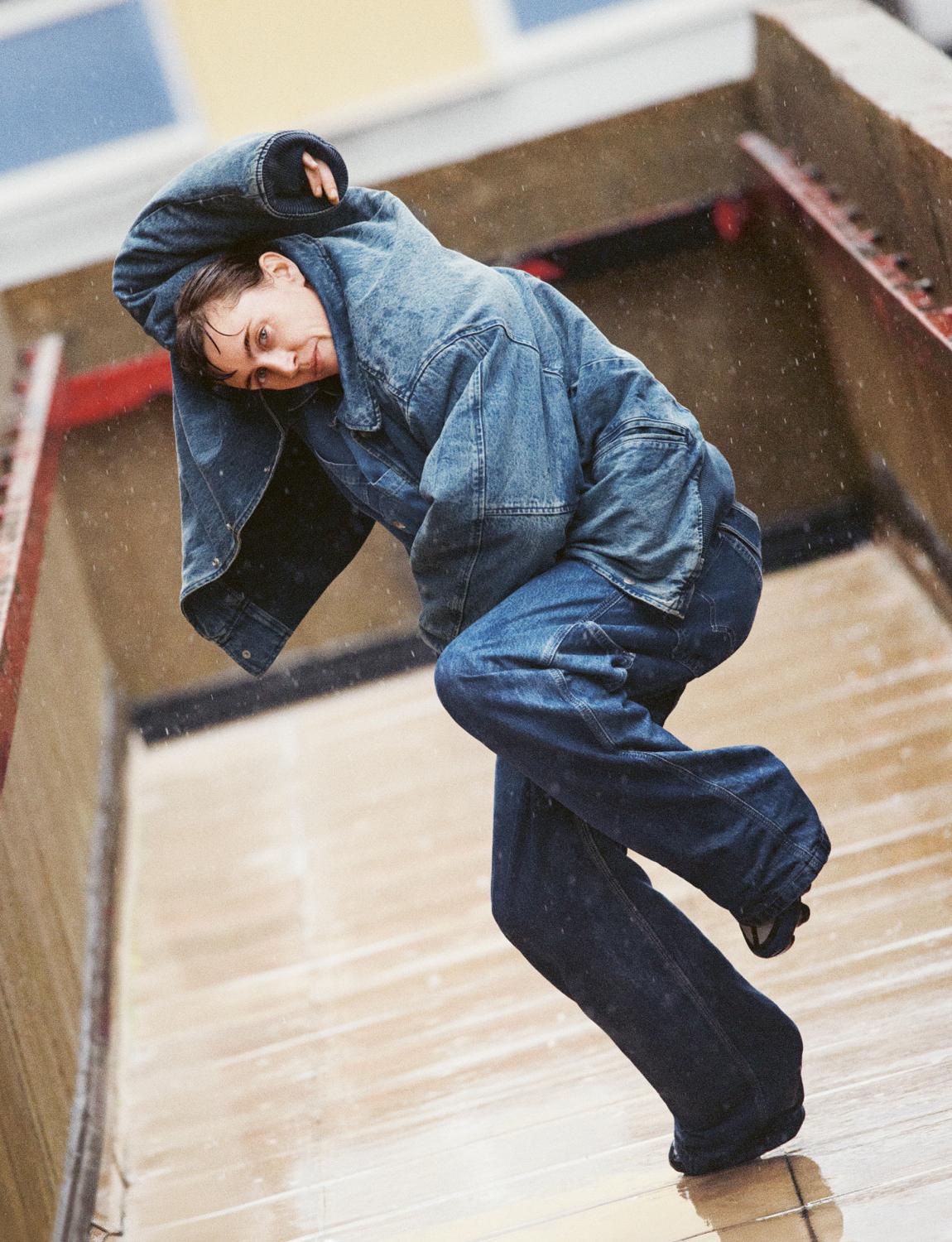
On the left, Oona is in an off-white cotton shirt by MIU MIU with cream cotton Warm Up trousers by TALIA BYRE. The leather shoes are also by TALIA BYRE. On the right, Oona makes it triple denim with the addition of a Reversible Shacket by LEVI’S. NIKE trainers, as before.
This autumn will see the unveiling of Oona’s latest work, Specky Clark, a piece inspired by her great-great-grandfather, with music by the Mercury-nominated folk band Lankum. Women will be played by men, the young Specky Clark by a woman. Sounds like an Oona Doherty show. “I wrote it because I moved to Marseilles, I think,” she says. “I thought, I’ll be like all those writers [Samuel Beckett, James Joyce] and move to France and write about Ireland.” Her work seems driven both by autobiography and a strong social conscience. “I guess so,” she says. “I mean, I need a really big reason to say to people, ‘OK, we’re going to look for £200,000 funding, and it’ll take a year to find, and we’re going to have to go out and audition.’ You have to have a reason, and for me it being aesthetically beautiful is not enough. It’s a big responsibility. It can’t just be because it’s pretty.”
Oona and Rosie moved to Marseilles in August 2023, ready for “petite section, little school,” Oona says. “It’s beautiful and hot and sunny. We can go to the beach, and the fruit and veg are brilliant. And I miss my friends, and I don’t speak French,” she adds, ruefully. “But I’ll do another year there for sure.”
When Hope Hunt hits its 10th anniversary in 2026, Oona will be 40, and she plans to star in it again. She misses dancing. “I wish I was dancing,” she says. “My mental health is in bits because I’m not. But the administration involved in running a company means I can’t. I’ve danced a bit giving someone a direction, but I’ve not done a full day. I’ve never got into a flow state.” What would it take to get into flow? “If I just had three hours,” she says mournfully, but not without humour. “If I had 45 minutes to warm up and danced for an hour I’d be grand.” But it’s still early days, she adds. “It’s the first two years of trying to be a choreographer and a mum, so I guess, yeah, it takes a while to learn how to do that.” Does the body suffer when she doesn’t dance? “Yeah,” she says. “I mean, I could be drinking less rosé and eating less crisps. That’d probably help too.”
“For me, a dance being aesthetically beautiful is not enough.”
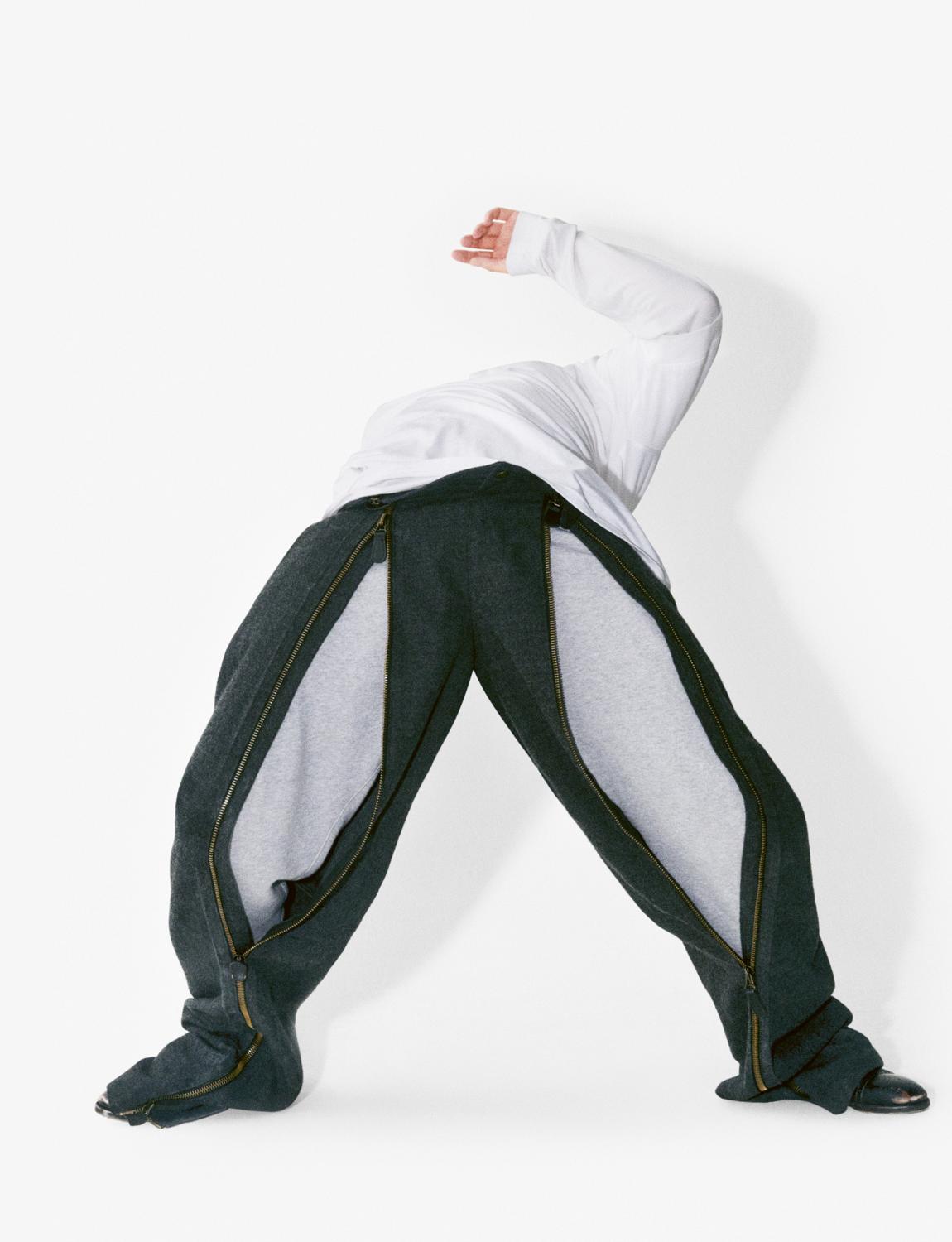
Halfway into bridge, perhaps: Oona is in a short-sleeved white cotton henley T-shirt over a long-sleeved white T-shirt, both by SUNSPEL. The grey wool BURBERRY trousers have nifty zips that go all the way up to the waistband – perfect for activities that require extra mobility. Grey tracksuit bottoms by SUNSPEL and leather shoes by TALIA BYRE.
Kate FinniganKate Finnigan is a writer, editor and creative consultant, and a regular contributor to publications such as Vogue, Telegraph Magazine and the Financial Times. Fancy.read more Photography by
Ilya LipkinFired up by pop culture and the history of photography, Ilya is a technical genius, brilliant portraitist and very nice man.read more Styling by
Eliza ConlonBorn and raised in Peckham, south London, the qualified art therapist and empathic stylist Eliza joined The Gentlewoman in 2018. Hooray! Her other clients include Acne Studios, Stella McCartney and Talia Byre. Eliza is passionate about using fashion and clothes as a creative outlet for the neuro-diverse,…read more
Hair: Alfie Sackett at LGA Management. Make-up: Crystabel Efemena Riley at Julian Watson Agency, using Manasi 7. Digital operation: Samuel Hearn. Photographic assistance: Bradley Polkinghorne, Stefan Ebelewicz. Styling assistance: Ellie Turner. Post-production: MCD Creative. Production: Lock Studios.
This profile was originally published in The Gentlewoman nº 30, Autumn and Winter 2024.